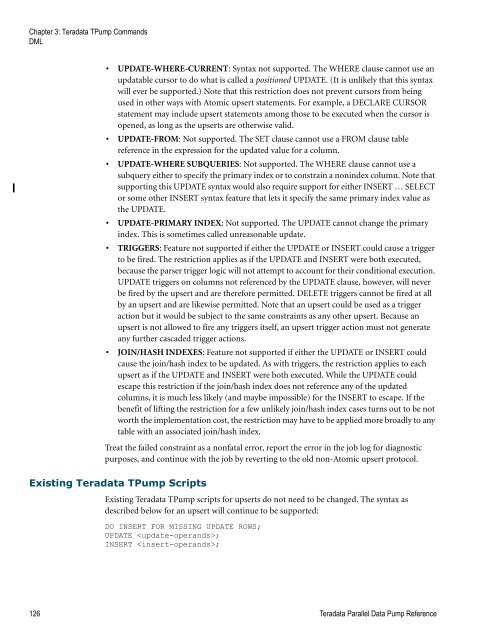Teradata Parallel Data Pump
Teradata Parallel Data Pump Reference - Teradata Developer ...
Teradata Parallel Data Pump Reference - Teradata Developer ...
- No tags were found...
Create successful ePaper yourself
Turn your PDF publications into a flip-book with our unique Google optimized e-Paper software.
Chapter 3: <strong>Teradata</strong> T<strong>Pump</strong> Commands<br />
DML<br />
• UPDATE-WHERE-CURRENT: Syntax not supported. The WHERE clause cannot use an<br />
updatable cursor to do what is called a positioned UPDATE. (It is unlikely that this syntax<br />
will ever be supported.) Note that this restriction does not prevent cursors from being<br />
used in other ways with Atomic upsert statements. For example, a DECLARE CURSOR<br />
statement may include upsert statements among those to be executed when the cursor is<br />
opened, as long as the upserts are otherwise valid.<br />
• UPDATE-FROM: Not supported. The SET clause cannot use a FROM clause table<br />
reference in the expression for the updated value for a column.<br />
• UPDATE-WHERE SUBQUERIES: Not supported. The WHERE clause cannot use a<br />
subquery either to specify the primary index or to constrain a nonindex column. Note that<br />
supporting this UPDATE syntax would also require support for either INSERT … SELECT<br />
or some other INSERT syntax feature that lets it specify the same primary index value as<br />
the UPDATE.<br />
• UPDATE-PRIMARY INDEX: Not supported. The UPDATE cannot change the primary<br />
index. This is sometimes called unreasonable update.<br />
• TRIGGERS: Feature not supported if either the UPDATE or INSERT could cause a trigger<br />
to be fired. The restriction applies as if the UPDATE and INSERT were both executed,<br />
because the parser trigger logic will not attempt to account for their conditional execution.<br />
UPDATE triggers on columns not referenced by the UPDATE clause, however, will never<br />
be fired by the upsert and are therefore permitted. DELETE triggers cannot be fired at all<br />
by an upsert and are likewise permitted. Note that an upsert could be used as a trigger<br />
action but it would be subject to the same constraints as any other upsert. Because an<br />
upsert is not allowed to fire any triggers itself, an upsert trigger action must not generate<br />
any further cascaded trigger actions.<br />
• JOIN/HASH INDEXES: Feature not supported if either the UPDATE or INSERT could<br />
cause the join/hash index to be updated. As with triggers, the restriction applies to each<br />
upsert as if the UPDATE and INSERT were both executed. While the UPDATE could<br />
escape this restriction if the join/hash index does not reference any of the updated<br />
columns, it is much less likely (and maybe impossible) for the INSERT to escape. If the<br />
benefit of lifting the restriction for a few unlikely join/hash index cases turns out to be not<br />
worth the implementation cost, the restriction may have to be applied more broadly to any<br />
table with an associated join/hash index.<br />
Treat the failed constraint as a nonfatal error, report the error in the job log for diagnostic<br />
purposes, and continue with the job by reverting to the old non-Atomic upsert protocol.<br />
Existing <strong>Teradata</strong> T<strong>Pump</strong> Scripts<br />
Existing <strong>Teradata</strong> T<strong>Pump</strong> scripts for upserts do not need to be changed. The syntax as<br />
described below for an upsert will continue to be supported:<br />
DO INSERT FOR MISSING UPDATE ROWS;<br />
UPDATE ;<br />
INSERT ;<br />
126 <strong>Teradata</strong> <strong>Parallel</strong> <strong>Data</strong> <strong>Pump</strong> Reference









